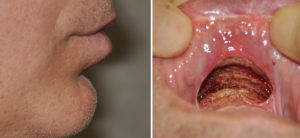The labiomental fold is the natural indentation that exists between the lower lip and the chin. It resides about 1/3 of the vertical distance between the lip and chin and is present in almost everyone to some degree. While called a fold, it is not really a fold but an indentation that is reflective of the lower extent of the vestibule intraorally. It exists because this is the level of where the origin of the mentalis muscle is as it takes off from the bone surface. Some fibers of the muscle insert into the deep dermis of the chin pad. Since one of the functions of the mentalis muscle is as an elevator of the central lower lip, the indentation can be come deeper with expression.
Very deep labiomental folds are often associated with short lower facial heights. Conversely, increased lower facial heights have more shallow effaced folds. Patients with normal lower facial heights have variable labiomental fold shapes. The aesthetics of the labiomental fold should be considered in any chin procedure since bony movement of the chin or its onlay augmentation is well known to affect the fold shape.
Another surgical issue that can affect the labiomental fold is intraoral surgical access to the chin. This requires cutting through the bony attachment of the mentalis muscle and then reattaching it during the closure. While not usually causing a labiomental fold problem the first time, repeat surgical entry may cause excessive scar tissue or a mentalis muscle reattachment that is very tight. This can make the labiomental fold deeper and/or feel very tight/stiff.


Most tight labiomental folds after chin surgery resolve over time. But if a tight and restrictive labiomental fold persists after 6 months or more of healing, release and tissue grafting is a treatment option.
Dr. Barry Eppley
Indianapolis, Indiana


